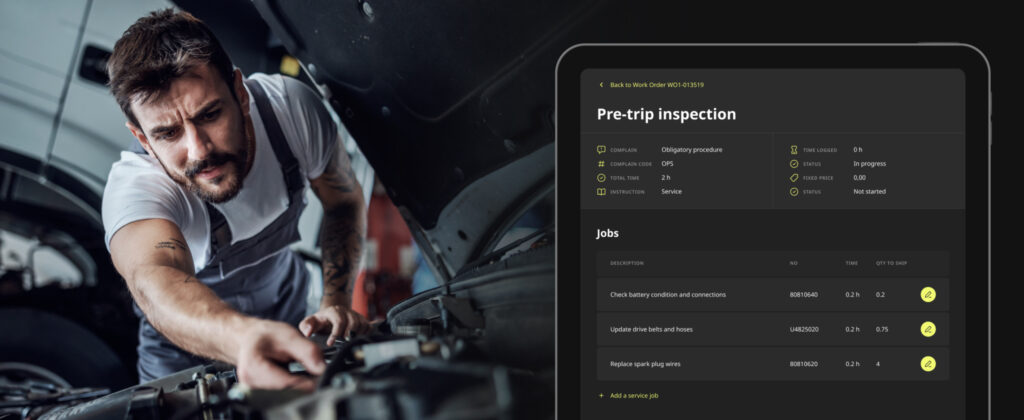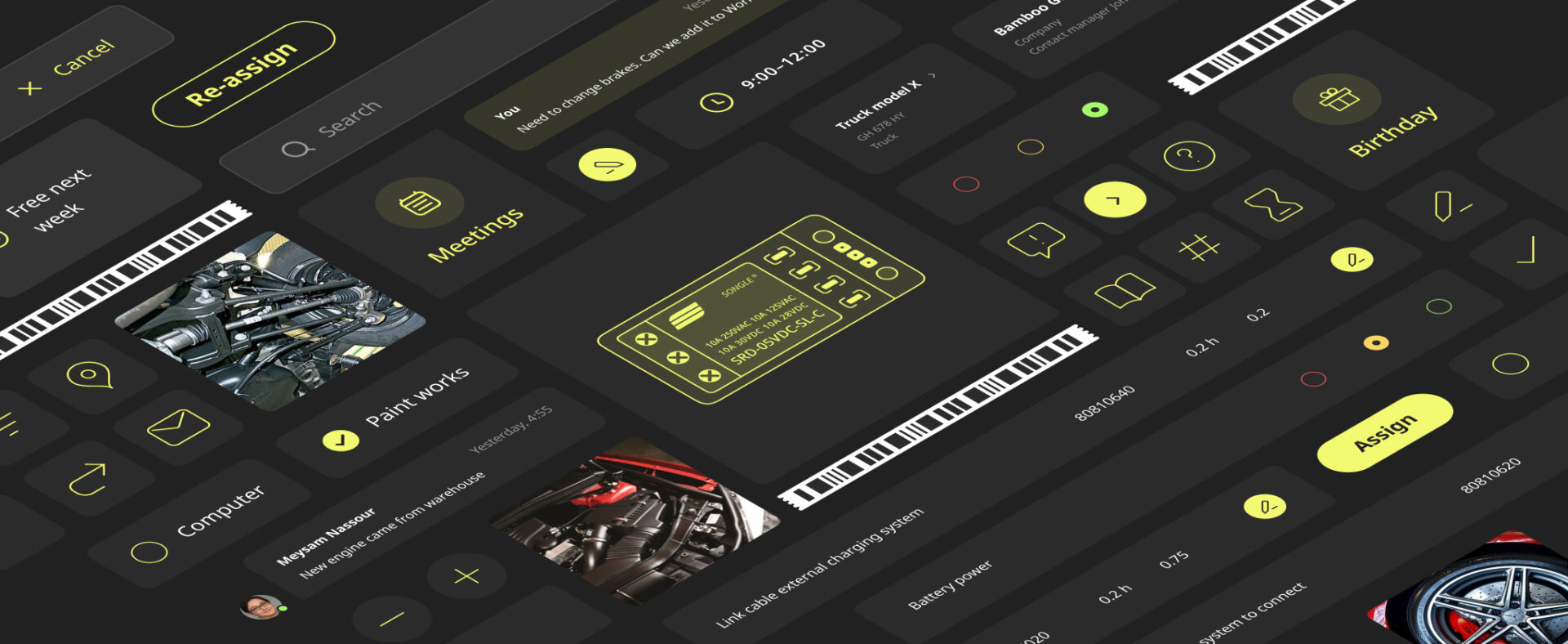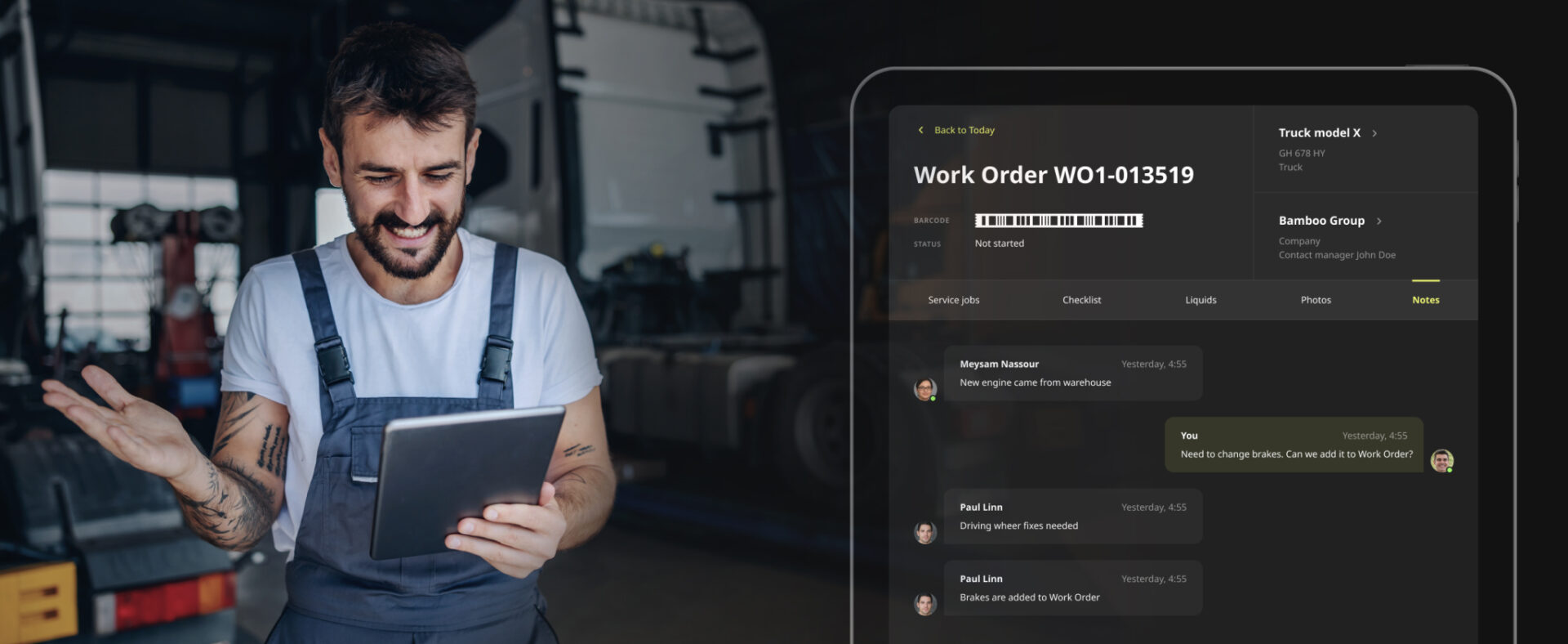Work order management software for trucks
A fleet management app concept aimed at improving efficiency and quality in the truck repair and maintenance industry
Services
UX/UI research and design
Concept development
Technology
Invision
Answering the demands of the fleet maintenance industry
The truck repair and maintenance industry faces several challenges that can impact the efficiency and quality of services provided to clients. From difficulties in communication and transparency, to issues in tracking service history and managing technicians, the market requires innovative solutions to meet the growing demands of its customers.
The team of Bamboo Apps was tasked with developing a concept for a software application that addresses these challenges. It would have to provide a centralised platform for clients to order truck repair and maintenance services, as well as for mechanics to manage and log progress on these orders.
Most importantly, the software would have to be designed for mobile platforms to support easy on-the-go communication and process tracking, which would equally benefit mechanics and their clients.

A one-stop-shop for fleet maintenance services
Bamboo Apps developed a concept for a mobile work order management software that features three distinct profile types for clients, mechanics, and chief mechanics. Clients can place work orders for truck services with detailed information on the issue at hand using their tablet. They can also attach photos and notes to the order.
Mechanics can view their work history and receive and complete orders, while chief mechanics have an overview of all mechanics’ activities in a calendar and can assign work to available mechanics on the go. Additionally, the app includes a vehicle profile and the ability for mechanics to send invoices for completed orders.
Empowering fleet owners and mechanics with a cutting-edge maintenance app
The application presents different features and data to different types of users. For instance, only chief mechanics can assign specialists to complete certain tasks – regular mechanics cannot give assignments to themselves or their colleagues. That said, most information is available to all user profiles.
Work order information
This is the screen that displays all one needs to know about a particular order. It’s segmented into several parts.
Basic information
The top of the screen features the order name, number, barcode, and status. To get a fuller picture of the problem, users can view detailed information about the order, vehicle, and the client by selecting their respective options.
Service jobs
The service jobs section shows information about the tasks that need to be performed for the vehicle. This includes such details as the type of service required, the mechanic assigned to the job, and the time spent on it.
Checklist
The checklist section displays the vehicle’s health using different metrics, such as oil pressure, belt tension, software updates, battery, and more. It provides a comprehensive overview of the vehicle’s condition and helps identify any potential issues. The feature is especially useful in a mobile format, since mechanics can check off completed tasks as soon as they’re done.
Liquids
The liquids section displays the status of in-car liquids, such as gas and oil. This information is important for monitoring the vehicle’s overall health and ensuring that it is functioning properly.
Photos
The photos section contains pictures related to the order, allowing users to provide visual proof of issues or concerns with the vehicle. This section provides valuable context for mechanics and clients, helping to ensure that orders are completed accurately and efficiently.
Notes
Finally, the notes section allows clients and mechanics to exchange notes about the order and its progress. This section provides a clear and direct communication channel in the form of an instant mobile chat, which improves transparency and ensures that all parties have the information they need.
Process management
The app gathers all the relevant information and activities in one mobile hub, thus boosting process management and work speed. To begin with, detailed work orders sent out by clients ensure that mechanics immediately receive all the necessary info.
This allows chief mechanics to assign relevant specialists to each order right away, using the app’s calendar functionality. Over the course of the work, the software makes providing and tracking updates very easy for both customers and service workers, thanks to the checklist, photos, notes.
When an order is finished, the assigned mechanics can request an approval from their chief mechanic. If everything is correct and the work quality is satisfactory, the client receives an invoice straight from the app.
Mechanic profile
Every mechanic has a profile listing their name, skills, contact information, and work history. Whenever a new order comes in, chief mechanics can filter their available staff by the skills necessary to complete the job.
Then, if the mechanic doesn’t have any work scheduled on the day the job needs to be done, they can be assigned to it in the calendar. Mechanics can also be texted using the messaging feature.
Vehicle profile
Each vehicle that arrives for service has its own profile, which lists detailed information about its hardware and warranty, as well as provides photos of the car. It also contains information on all the previous works done on the vehicle.
The short vehicle information section includes:
- vehicle number
- brand
- type
- configuration
- engine
- engine type
- time of arrival
- time of departure
The warranty information section includes:
- expiry date
- APK
- tacho
- warranty period
- driving line warranty period
- importer R&M period
This kind of comprehensive overview is extremely useful for both mechanics and customers, as it allows users to understand and resolve issues in no time.

Navigating the complexities of fleet maintenance software design
When designing the fleet maintenance app, the development team at Bamboo Apps faced a couple of challenges.
User experience
Work order systems for maintenance in the Automotive field aren’t exactly common. So ensuring that the app concept was intuitive, user-friendly, and efficient for all three user types (clients, mechanics, and chief mechanics) was the first challenge.
Our experts used a combination of user-centred design principles, industry knowledge, and years of UX design experience to come up with a fleet maintenance app that meets the complex needs of clients, mechanics, and chief mechanics with equal success.
Data organisation
This was another challenge that stemmed from the lack of exemplary fleet maintenance work order systems on the market to use as reference. Finding a good way to display large amounts of data, such as vehicle information, client information, and order information was a challenge.
To that end, our UX/UI designers decided to logically segment these heaps of data into multiple screens and sections, thus keeping all the info easily accessible and organised.
Integration possibilities
In theory, there are a lot of solutions work order management systems would need to interact with.
We had to think how the app would integrate with payment systems and consider the possibility of integrations with special invoicing and accounting software. Optimally, our concept had to be designed in a way that would minimise the reliance on third-party services.
In the end, our extensive industry research and professional experience in automotive and fleet management software design helped us resolve these challenges and deliver an intuitive and efficient solution concept.

A conceptual solution to improving truck maintenance services
The resulting app concept demonstrated an effective way to answer the demand for transparency, easy maintenance history tracking, better communication, and improved process organisation in the truck repair and maintenance industry.
It showed that there is great value in digitising the sector, and that mobile work order management systems for service centres are worth investing in for the sake of enhancing the experience of both customers and professional mechanics.












